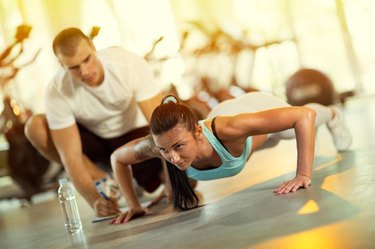
When it comes to full-body exercises, the push-up may be as close to one-stop shopping as you can get. Push-ups work muscle groups in the neck, arms, shoulders, chest, back and, even to some extent, the abs. Plus, you can do them at any time and anywhere.
How many reps make a workout? For some people, it's three sets of 10. Others derive a sense of virtue from an even 100. Some people don't count, they just do as many as possible.
Video of the Day
Video of the Day
Understanding more about the benefits of push-ups can help you design the right workout for your goals.
Read more: Pros and Cons of Daily Push-Ups
Variety Is the Spice of Life
If your goal is building muscle, it's important to bring yourself to the point of muscle failure with each set, however many that takes.
"Anyone who does three sets of 10 reps of push-ups is doing themselves a great favor," says Los Angeles-based personal trainer David Knox, author of Body School: A New Guide to Improved Movement in Daily Life.
"But why stop there? One of the many great things about push-ups is you can do all sorts of variations on them. And there are as many rep-set strategies as there are variations."
Doing push-ups at a decline with your feet elevated intensifies the workout while doing the reverse — incline push-ups — makes for easier work, but but still notably activates the triceps and the anterior deltoids.
"Variety is really important for body weight exercises because doing the same exercise routine day after day can become tedious very quickly. With weights, you can keep yourself interested by adding more weight. With push-ups, you have to add variation," notes Knox.
Read more: 10 Push-Up Variations for a Stronger Body

Rep Strategies
Beginners benefit from choosing one push-up exercise and aiming for two sets of 10 to 15. From there, work your way up to two or more push-up variations, adjusting the number of reps according to the number of exercises and sets you're attempting — a common recommendation is eight to 12, but really, the only limit is what your body can handle.
Pyramiding
Pyramiding is a great way to warm up, reach maximum effort and cool down. Begin by doing a small number of push-ups — let's say two. Rest 30 seconds and then do four.
Work up to a pre-determined number peak; half of your maximum is a good place to start. Then work backwards, decreasing each set by the same number you added until you're back to two.
Ladders
With ladders, you build your reps in the same way as pyramiding, but instead of tapering down, you build up to your peak and leave it there.
Doing Push-Ups Correctly
Obviously, a review of the basic push-up form is in order. While doing push-ups, your reps only count if they're done correctly. That means keeping your head in alignment with your spine and your feet together.
Your toes should be tucked and your heels should project behind you. Avoid sagging of the back or rib cage or letting your hips jut upward; keep your elbows slightly flared outwards at a 45-degree angle with your torso. Maintain stability by keeping your butt and thighs engaged.
HOW TO DO THEM: Start by getting on your hands and knees. Your hands should face forward or point just a little inward and be placed directly under your shoulders. Brace your stomach muscles and pull back your shoulder blades.
Assume plank position by extending one leg out at a time. (Beginning this way prevents back strain.) Bending your elbows, slowly lower your body to the ground, keeping the torso straight. The goal is for your chin or chest to make contact with the ground.
Push upward through your arms, straightening the elbows. Imagine that you're trying to push the floor away.
Read more: What Are the Benefits of Push-Ups?